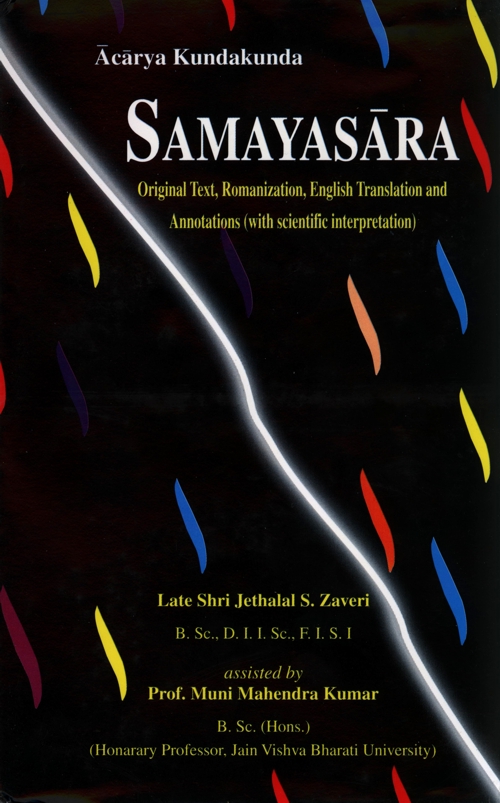
micchattaṃ aviaramaṇaṃ kasāyajogā ya saṇṇasaṇṇā du.
bahūvihabhedā jῑve tasseva aṇaṇṇapariṇāmā..1

ṇāṇāvaraṇādῑyassa te du kammassa kāraṇaṃ hoṃti.
tesiṃ pi hodi jῑvo rāgaddosādibhāvakaro..2
(Micchataṃ aviramaṇaṃ kaṣāya -jogā ya saṇṇasaṇṇā du) Perverted world-view, non-abstinence, passions and [threefold] activities are of two categories: bhāva or psychic and dravya or physical; (jῑve bahuvihabhedā tasseva aṇanṇa pariṇāma) [of these what are psychic] are determined by the soul, are of many types and are psychic states or modes.
(Te du ṇāṇāvaraṇādῑyassa kammassa kāraṇaṃ hoṃti) Those perverted world-view etc. [of the physical category] become primary causes of knowledge-obscuring and other species of karma (tesiṃ pi rāgāddosādi bhāvakaro jῑvo hodi) while attachment aversion and the like, which are psychic states, become auxiliary causes of these and are determined by the soul.
Annotations:
In the third chapter (verses 3.41, 3.42) fourfold primal conditions of bondage were dealt with, viz.:
- Perverted world-view-mithyātva
- Non-abstinence-avirati
- Passions- kaṣāya
- Activities-yoga
In the above verses of this chapter, the same conditions are dealt with as the primary causes of the inflow of karmic matter i.e. Āśrava. We have already studied the nature of these four earlier, so we shall just briefly recapitulate them here for ready reference.
- Mithyātva is the beginningless form of defded consciousness infected with delusion produced by the deluding darśana-mohanῑya karma.
- Avirati (or aviramaṇa) means intense attachment of the soul to alien objects and its inability to abstain from the sinful path.
- Kaśāya means fourfold passions—anger, arrogance, deceit, and greed. Both (ii) and (iii) are responsible for producing perverted conduct and are the results of cāritra-mohanῑya karma.
- Yoga means threefold activities which produce vibrations and attract the karmic matter for bondage.
- In these opening verses the author initiates the discussion by emphasizing that distinction has to be made between the two categories of cause of inflow of karmic matter—āśrava:
- Psychic cause or bhāva āśrava and
- Physical cause or drvaya āśrava. Though both are concomitant, they are not identical as they are substantively different and distinct.
Earlier, we had occasion to criticize the Sāṃkhya system which believes in absolute immutability of the conscious substance and, therefore, stresses that evils of the world do not belong to it. Jains, on the contrary, as we have seen, do not accept the propriety of such position. If the soul is involved in evils, the evils must belong to the soul, because the conception of cruelty, anger etc. loses all its meaning and purpose unless the soul is really associated with them. Thus, we have an evil associated with the soul and an evil associated with karmic matter. The former is bhāva āśrava or psychic evil and the latter is drvaya āśrava or physical evil. Hence the four primal causes of influx are to be split in two categories (series):
Psychic series -I | Physical series-II |
|---|---|
Psychic perversion—bhāva mithyātva | Darśanamoha—dravya mithyātva |
Non-abstinence—psychic weakness | Cāritramolia Dravya avirati |
Psychic distortions—bhāva kaṣāya | Cāritramoha—dravya kaṣāya |
Psychic unsteadiness—bhāva yoga | Physical activities—mental, vocal, bodily-Dravya Yoga |
The fourfold conditions of category II become the substantive or primary causal agency (upādāna karaṇa) for the bondage of the eight species of karma:
- Knowledge-obscuring—jñānavaraṇa
- Intuition- obscuring—darśanāvaraṇa
- Deluding—mohanῑya
- Obstructing—antarāya
- Body-building—nāma
- Status-determining—gotra
- Pleasure-/Pain-producing—vedanῑya
- Life-span-determining—āyuṣya
These eight species of karma are modifications of karmic matter of which the substantive cause is dravya āśārava and auxiliary cause is bhāva āśrava.
 Jethalal S. Zaveri
Jethalal S. Zaveri
 Prof. Muni Mahendra Kumar
Prof. Muni Mahendra Kumar

